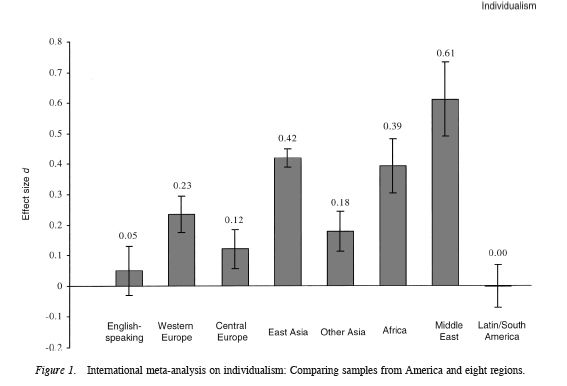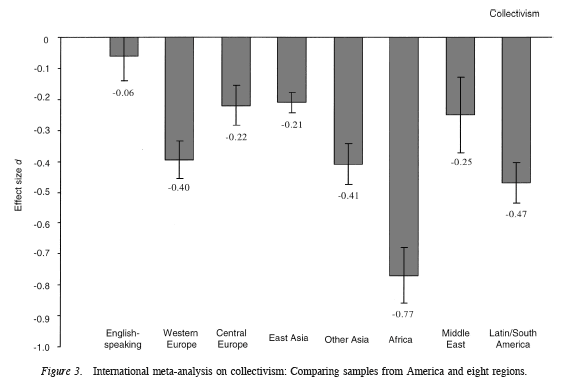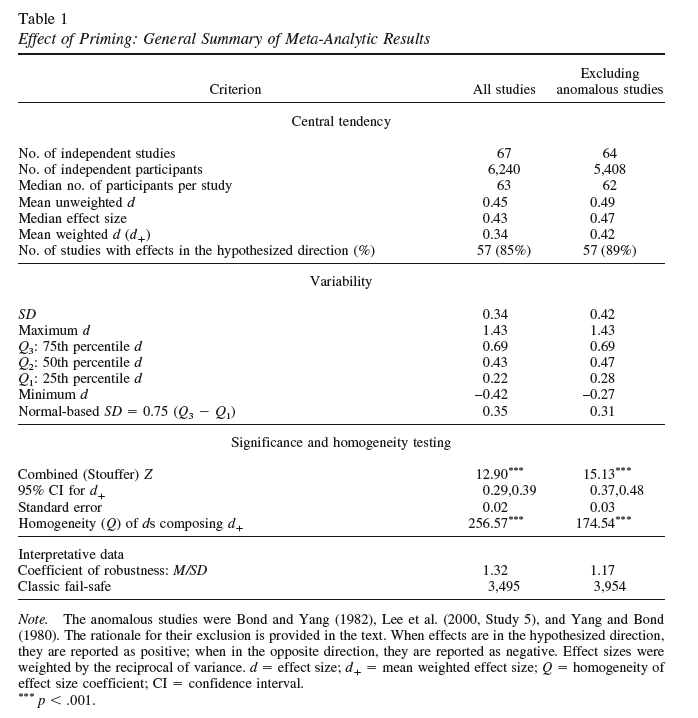How to turn Americans into Asians (or vice versa)
« previous post | next post »
Continuing to follow up on the issues raised by David Brooks' column "Harmony and the Dream", I recommend some interesting reviews by Daphna Oyserman and her colleagues. Among her many publications on culture I found two articles that are especially relevant.
The first is Daphna Oyserman, Heather Coon, and Markus Kemmelmeier, "Rethinking Individualism and Collectivism: Evaluation of Theoretical Assumptions and Meta-Analyses", Psychological Bulletin 128(1): 3-72, 2002. The abstract starts like this:
Are Americans more individualistic and less collectivistic than members of other groups? The authors summarize plausible psychological implications of individualism–collectivism (IND-COL), metaanalyze cross-national and within-United States IND-COL differences, and review evidence for effects of IND-COL on self-concept, well-being, cognition, and relationality.
This 70-page paper is full of interesting details, but I'll limit myself to reproducing two figures, derived from meta-analysis of many studies that operationalize individualism and collectivism in many different ways.
The first figure compares Americans to citizens of other regions or countries in terms of individualism:
The second figure does the same thing for a meta-analysis of measures of collectivism:
The vertical axis is "effect size" estimates, which show the average difference between the groups, normalized by within-group standard deviations. (See the Wikipedia article, or this old Language Log post, for a discussion of effect sizes.) Positive effect sizes mean that Americans are on average higher in the quality being measured; negative effect sizes mean that they are lower.
These are moderate to large effects — so David Brooks is right, right? On average, Americans are more individualistic and less collectivistic than East Asians.
Details aside, that's the pattern. But now we need to look at another review article: Daphna Oyserman and Spike Lee, "Does culture influence what and how we think?", Psychological Bulletin 134(2): 311-342, 2008. The abstract:
Do differences in individualism and collectivism influence self-concept content, relational assumptions and cognitive style? On the one hand, the cross-national literature provides an impressively consistent picture of the predicted systematic differences; on the other hand, the nature of the evidence is inconclusive. … To address these issues, a meta-analysis of the individualism and collectivism priming literature was conducted … Results lend support to a situated model of culture in which cross-national differences are not static but dynamically consistent due to the chronic and moment-to-moment salience of individualism and collectivism. Examination of the unique effects of individualism and collectivism versus other cultural factors (e.g., honor, power) awaits availability of research which primes these factors.
What Oyserman and Lee mean by "priming" is typically accomplished by having the subjects engage in some brief and simple task before being tested, or by manipulating the test setting. The research then examines how differences in priming affect responses to the subsequent test. In this review, they considered a range of studies that used seven different kinds of priming:
1. Task context. Collectivism is primed by "… being seated at five-person tables, working as a group, giving the group a name, being told that points were rewarded to the group, and competing against other groups). Individualism priming involved performing the task individually and being seated at single-person desks separated by partitions".
2. Imaginary task context: Collectivism (individualism) priming involved imagining oneself competing on a tennis team (in a singles match) or imagining one’s family (oneself) consuming grape juice.
3. Ways of thinking about interpersonal relationships. For priming individualism: “For the next two minutes, you will not need to write anything. Please think of what makes you different from your family and friends. What do you expect yourself to do?” For priming collectivism: “For the next two minutes, you will not need to write anything. Please think of what you have in common with your family and friends. What do they expect you to do?”
4. Circling pronouns. To prime individualism, subjects read a printed passage and circle the pronouns I, me, my. To prime collectivism, they circle we, us, our.
5. Unscrambling sentences. Subjects unscramble randomized lists of words to form a sentence. To prime individualism, the words are draw from a set that includes I, me, mine, distinct, different, competitive, own, free, unique, dissociate, assertive, unusual, autonomy, alone, apart, autonomous, detached, different, dissimilar, distinct, diverge, independence, individual, isolate, separate, solitude, split, unique, and self-contained . To prime collectivism, the words used include we, us, ours, join, similar, alike, share, cooperative, agreeable, help, group, respect, partnership, together, team, support, others, attached, alliance, closeness, cohesive, connection, inseparable, interdependence, intimate, joint, merged, overlap, similar, shared, together, union, and friendships.
6. Sumerian warrior story. Subjects are given the following instructions: “We would like you to read a couple of paragraphs on the following page. After reading these paragraphs, you will be asked to make a judgment about the main character”. The participant is then given a text to read that focused on choosing a warrior on the basis of either individual talent (for priming individualism) or tribe membership and family considerations (for priming collectivism).
7. Language priming. Bilingual participants are instructed and tested in English or in another language . "The assumption is that English carries with it knowledge about American or Anglo-Saxon culture and so evokes individualism, whereas other non-Western languages carry with them knowledge about a home culture assumed to be more collectivist".
All of these priming methods are apparently effective to one degree or another. There are interesting differences in terms of which priming methods are effective to which degree for which measures on which subjects — but the crucial take-home message is that across the 67 studies surveyed, each using one or another of these simple and brief priming methods, the median result was an effect size of about 0.47 — which is similar in magnitude to the regional differences in the earlier survey.
From Daphna Oyserman's statement of research interests:
The experimental work demonstrates that the influence of temporal inductions of independent or interdependent self-construals parallels differences between independent and interdependent cultures; i.e., Westerners can be “turned into” Asians through a short priming task, highlighting the crucial role of self-construal. Current research extends this work by showing that temporary inductions of an independent or interdependent self-focus shift basic perceptual processes.



Garrett Wollman said,
August 15, 2008 @ 9:35 pm
The paper includes the first extended definition I've seen for "collectivism" that boils down to something more than "a pejorative term used by libertarians to label policies and beliefs they disagree with".